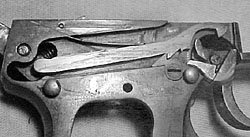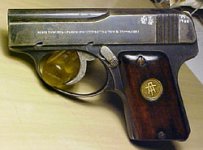Alois Tomiška’s Little Tom Pistol
by Ed Buffaloe
Photographs by Roger Coole
Alois Tomiška was born in Pardubice in what is now the Czech Republic on 13 February 1867. The name Tomiška literally means “little Tom.” He was apprenticed to a gunsmith in Vienna, Austria in the 1890’s. Tomiška received his first patent for what was to become the Little Tom pistol in 1908 (British patent 13880), and patented modifications to it in 1910 (British patent 23927) and 1913 (British patent 3439). He received a German patent (218897) in 1910, though it differed considerably from the production gun. He received a French patent (421.509) also in 1910. Hogg and Weeks state that Tomiška produced the Little Tom between 1908 and 1915, but R.J. Berger doubts that any but prototypes were made during this period. According to Berger, Tomiška moved to Pilsen, Czechoslovakia in 1918, where he began production of the Little Tom by hand, producing just over 2000 pistols by 1921. Tomiška sold the rights to Wiener Waffenfabrik in Vienna, which produced the Little Tom until 1925 (with a total production between 17,000 and 28,000 pistols).




